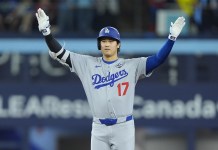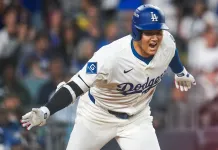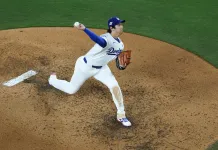The reigning World Series champions had some decisions to make, but none more difficult than what to do with Freddie Freeman. The 32-year-old first baseman was drafted by the Atlanta Braves in 2007 and spent his entire career with the franchise, right up until the Braves made a trade to acquire A’s first baseman Matt Olson. That signaled the end of an era and a very emotional day for the organization. Otherwise, Jorge Soler signed with the Marlins but the Braves kept most of their core group intact.
With a few depth additions and a couple of key bullpen acquisitions, this team is poised to make another run at the Commissioner’s Trophy. The division is not easy and neither is the road to a repeat, but Atlanta brings another strong team into the 2022 season.
2022 VSiN MLB Betting Guide
Offense
The biggest “free agent” addition is getting Ronald Acuna Jr. back from a torn ACL, as the Braves managed to win it all without their star outfielder. His return is slated for early May as a DH and he’ll be back in the outfield a little later. In a lot of respects, this is his team now. The 24-year-old was on pace for a career year with 4.2 fWAR in 82 games when he blew out his knee just before the All-Star Break. He was on pace to top the 41 homers he hit in 2019 and had cut down on his strikeouts.
During that 2019 season, Acuna had 57 “barrels,” which represent batted balls with an expected batting average of .500 or better and an expected slugging percentage of 1.500 or higher. In 2021, he had 44 “barrels” in effectively half a season. His contact quality was off the charts and he should get right back on track.
%%offer%%
Acuna’s return is critical because the Braves likely won’t get the same level of production from Olson that they did from Freeman. Olson does leave Oakland, which will help, but his wRC%plussign% projections are in the 130s as opposed to the 140s for Freeman. It isn’t a big drop-off, but the Braves are also without Soler, who posted a 132 wRC%plussign% in his 55 games. They’re also hoping Austin Riley can repeat his 135 wRC%plussign% from 2021, as he bashed 33 homers with a .368 BABIP. Because home runs are not technically balls in play, they don’t count towards BABIP. It is rare to see a player with that many home runs and a BABIP that high. His batting average will go down, which will take down his OBP with it.
Ozzie Albies suddenly popped a 30/20 season with 30 homers and 20 steals for the first time. He’s in his age-25 season, so maybe we’ve just reached his peak, but his contact quality took a massive leap forward with a career-high exit velocity and Hard Hit%.
It’s worth noting that all of these changes have the chance to stick. The Braves have been one of the most aggressive teams when it comes to increased launch angles. It’s a huge part of their offensive philosophy to hit fly balls and numerous guys have seen power spikes as a result. If we exclude pitcher plate appearances, the Braves were fourth in FB% and second in Pull%. These power increases are by design.
A guy such as Adam Duvall, who will be counted on to replace some of the lost production, has posted a FB% of about 55% in his three seasons with the Braves. When he came back via trade from the Marlins, he hit 16 homers in 55 games. Olson is pretty consistently in the 44% range, but I’d expect to see a spike there and also more pulled balls after a 7% drop in Pull% last season. He still hit 39 home runs.
The Braves are one of the NL teams that really benefits from the DH. They have a lot of hitters and some decent bench depth, so they can use the spot to rotate fielders in and out for a quasi day off or simply use somebody in that role full-time when Acuna returns to the outfield.
The craziest part about the World Series run is the Braves were only 88-73 during the regular season but went 11-5 in the playoffs to claim the ultimate prize. Their Pythagorean Win-Loss was 94-67. They were a pretty pedestrian team through July until improving the offense led to a 36-19 record down the stretch. The Acuna injury forced them to add guys such as Duvall, Soler and Joc Pederson, all of whom paid big dividends. Their offensive philosophy works and works well in today’s high strikeout, low batting average environment.
Pitching
The luxury for the Braves is they didn’t have to touch the starting rotation. Years of sound trades and prospect development have given Atlanta plenty of arms to choose from, and many of them are above league average. The area they needed to address was the bullpen, and they did exactly that by signing former Dodgers closer Kenley Jansen and Astros and Rays reliever Collin McHugh. Kirby Yates was also signed in November and should make his Braves debut after the All-Star Break (he had Tommy John surgery).
The Braves also signed some non-roster invitees with MLB experience such as Darren O’Day and Brad Brach, so this is a deep bullpen capable of overcoming the additional strain from a long postseason run. This is an area Atlanta clearly targeted and with good reason. It was not a good bullpen for a good portion of 2021, but everything came together late to become a big advantage in the postseason.
Overall, Atlanta’s bullpen was 13th in fWAR, 10th in ERA and 12th in FIP, but fourth in ERA and ninth in FIP in the second half. The top four relievers in appearances are all back and ranged from a 1.98 ERA to a 3.78 ERA and a 2.69 FIP to a 4.17 FIP, with Will Smith actually bringing up the rear in the FIP department during a down year for him. Add Jansen and McHugh and this projects to be a top-10 bullpen.
Eight of the 11 guys who started a game for the Braves last season are back, with Mike Soroka likely to rejoin the fold at some point after missing most of 2020 and all of 2021. One that is not back is Drew Smyly, who posted a 4.75 ERA with a 5.36 FIP in 115.2 innings. The big three of Charlie Morton, Max Fried and Ian Anderson had ERAs ranging from 3.04 to 3.58. Anderson was the only one with a FIP above 4, due in large part to a heightened walk rate.
While the Braves actively try to elevate the ball on offense, they actively try to induce ground balls on the pitching side. Morton, Fried and Anderson all had GB% marks of 47.8% or higher. Huascar Ynoa, whose season was shortened by an ill-advised punch of a locker, was at 47.2%.
Tucker Davidson looks likely to grab the No. 5 spot in the rotation following four solid starts last season at the MLB level and a good, albeit small, sample size at Triple-A. Kyle Muller and Touki Toussaint are good for rotation depth, plus Soroka at some point, so the Braves should run at least eight deep with competent arms.
Outside of Morton, who turns 39 this year, the Braves have four starters under 29, so this group should be able to bounce back from last year’s elongated season. They’re also well-equipped on the depth front for the expedited spring training. Some teams won’t have enough MLB-caliber arms. That won’t be an issue here, barring multiple injuries.
Player to Watch
SP Ian Anderson: Anderson was solid in his first full MLB season with a 3.58 ERA and a 4.12 FIP. There’s more potential in the young right-hander than what we saw, but it could take a philosophical change to get there. The Braves seem fairly content to keep him as more of a pitch-to-contact worm killer with ground balls. He could generate more swings-and-misses, and changeups have become excellent swing-and-miss pitches as hitters try to create more lift with their swing planes. The problem for Anderson is he throws his changeup too hard and hitters are able to drag the bat through the zone. They’re not making quality contact, but they are making contact. Anderson’s change sits in the 87-88 range, so it’s more like an old-school two-seamer. If he threw it slower and created more time for movement, he’d generate more swings and misses and likely up his ceiling in a big way. It’s something I’ll have my eye on early in the year.
Season Outlook
The Braves are the reigning World Series champs, which you’d think is the explanation for why they are the NL East favorites over a team with Jacob deGrom, Max Scherzer and a bunch of high-priced talent. I think it’s more about how good Atlanta is. This team has no apparent flaws and will add a big piece who wasn’t part of the World Series run in Acuna. This is a high win total, though, and one I won’t be playing. The Mets look good and the Phillies look much better. I also have a soft spot for the Marlins, who could be better than expectations. The only punching bag is the Nationals, who will squander a prime season of Juan Soto. Wins are not easy to come by in this division, even if the Braves look like a strong team again. They’ll be hard to bet against on a daily basis with an offensive philosophy I love and a lot of pitching depth, so it’ll be about finding spots to be on or against them rather than rooting for or against futures.
Win Total Lean: Over 90.5





